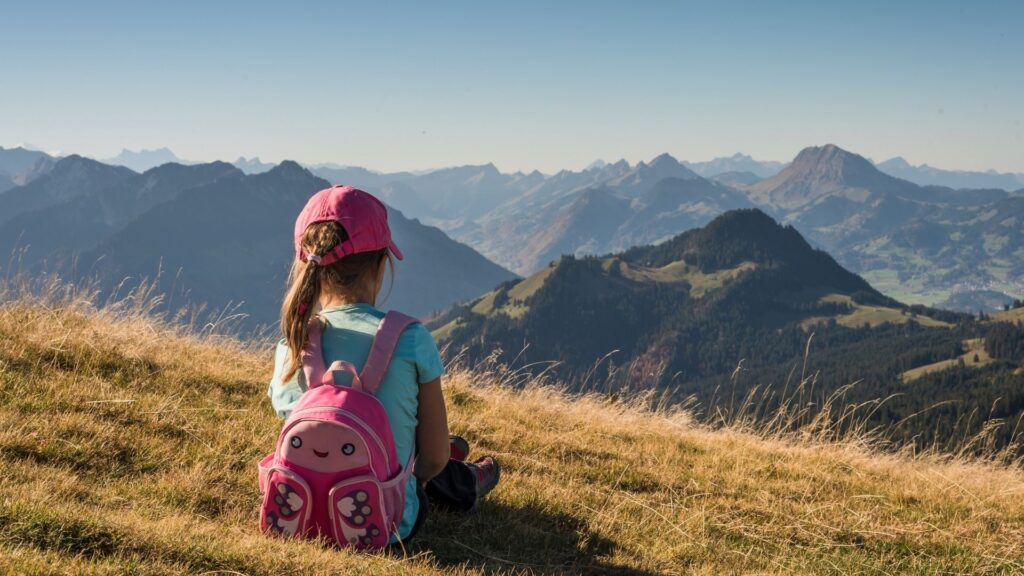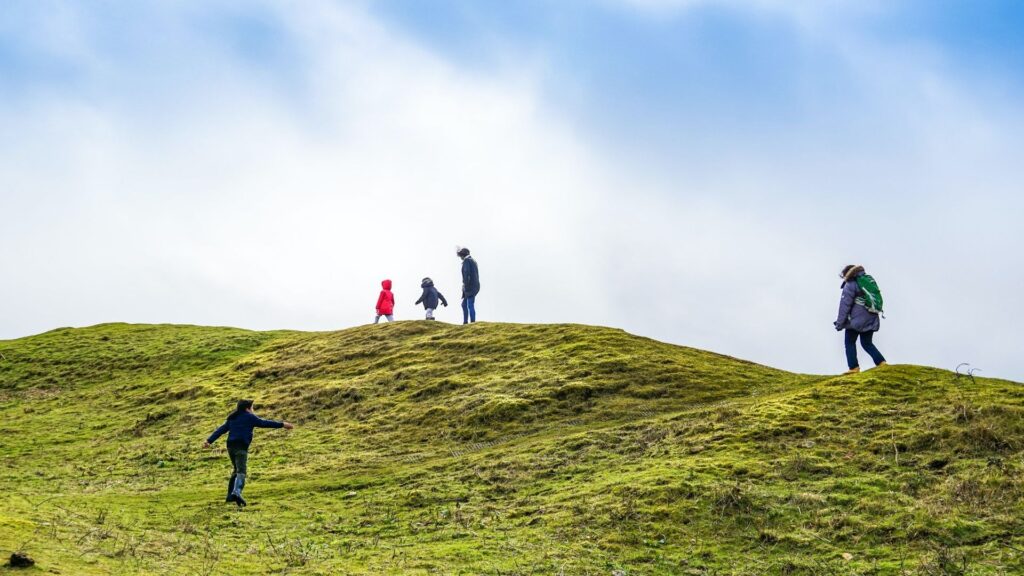Hiking is great exercise and can foster a love of nature in your children but only if they have fun doing it. As parents, we all know that if the kids aren’t having fun then it’s a good bet that no one will have a good time.
If you were a hiker before having kids it’s natural to want to incorporate them into your pastime. But like anything you do with your kids, it will have to be modified from how you probably did your hikes before they came along.
We’ve been down this road and learned the hard way so you don’t have hikes that end in tears and tantrums.
Table of Contents
Benefits of hiking with kids
Taking your children hiking has lots of benefits for both you and them.
- Hiking is great exercise
- Bonding experience
- Chance to instill a love of nature
- Build self-confidence
- Lets you both unplug from technology
- Being outside boosts your immune system
- Build coordination and balance hiking on rough terrain
- Hiking can be a gateway to other outdoor activities such as rock climbing, backpacking, and mountain biking
Pitfalls of taking kids hiking

When you take your kids on a hike you can run into a few obstacles that can ruin your day. Be aware of these issues to keep a fun hike from turning into a public meltdown.
- They get tired out easily
- Low tolerance for getting bitten by bugs
- Short attention span
Our tips will help you mitigate these pitfalls and move you on your way to happy hiking with your kids.
Happy feet
Like any hiker, your kids will have a better time if their feet aren’t sore or blistered. Proper hiking boots or shoes will give them traction and support. Avoid the temptation of buying shoes that are too big to give them time to grow into them as this will increase the risk of blisters.
Make sure they are wearing merino wool or synthetic socks as cotton gets wet and increases the risk of blisters. Bring spare dry socks to switch out if their feet get wet.
Regularly check their feet during hikes to make sure they aren’t getting hotspots which can lead to blisters. We have found kids aren’t good at letting us know until it has already formed a blister. If you find the shoe is rubbing you can prevent a blister by putting a piece of tape or moleskin over the affected area to stop the friction on the skin.
Start short
Like their little legs, start with short hikes and increase the duration as they grow. Just like a fitness program for adults you want to start with something that is manageable and relatively easy so they have a good time.
Gradually increase the distances and duration over time as they get used to longer hikes.
Let the kids set the agenda

Get your kids in on the planning process from where to go to the goal of the hike. When they are involved in the creation of the project they are much more likely to take ownership in making it successful.
From helping choose where to go, what to do, and planning the route they get to be part of the team rather than just along for the ride. We find this helps them learn skills and build self-confidence.
Take your time
Even if you want a killer cardio workout, remember that kids have short legs and poor stamina. Let them set the pace and plan lots of breaks.
When we hike with our kids we focus on exploring rather than getting from point “A” to point “B”.
Letting them set the pace also has the benefit of teaching them autonomy and responsibility. Let them know that they are in charge of looking after everyone and you may see a change in attitude. They will start asking if everyone is doing okay and people need a break.
Find interesting trails
Kids have short attention spans and get bored easily so if you can find a trail that is interesting then you will be able to hike longer. Rough terrain that requires scrambling and climbing is a favorite of our kids.
Lookouts, boardwalks, and interpretive displays can all be good to break up the hike and get the kids involved.
Anything that they can look forward to is good for keeping them going so let them know if something cool is coming up on the trail.
Clean up
When out hiking we like to bring a garbage bag and a mechanical trash picker. We make a game of spotting and picking up any garbage people have left on the trail. This is fun for the kids and instills an ethic of “Leave No Trace”.
It has the benefit of slowing down the hike to a pace manageable by the kids while also giving them a sense of accomplishment when they see how much garbage they have collected by the end of the hike. When other trail users see people cleaning it often leads to people littering less and pitching in for some garbage pickup of their own.
Bring a friend
An easy way to make hiking more fun for your kids is to bring a friend. When playing with each other, kids seem to find an endless well of energy.
When they are playing they tend to occupy each other and we find our kids whine less when their friends are around. Since we take our kids on hikes regularly, they fall into a mentor role teaching their friends about the outdoors. We find it leads to the guest child bugging their parents to get into hiking as well.
Learn to Geocache
Geocaching is a treasure hunt in the real world. You download the location of the caches from Geocaching.com to your phone or handheld GPS unit start searching. They will be things like hidden ammo cans. You get points for logging the caches you find.
Kids love the exploring and treasure hunt nature of geocaching and the reward that comes when they find the prize. Just about everywhere has geocaches that have been placed by enthusiasts just waiting for you to find them.
We have located geocaches in urban settings, along trails, deep in the woods, and even on a ledge halfway up a cliff while rock climbing. The kids love the hunt and push us to keep looking for new geocaches.
Search for wildlife
Become wildlife explorers and search the woods for animals. Even a city park can be home to birds, squirrels, rabbits, raccoons, and even deer. Bring along a pair of binoculars to help spot distant animals.
With a small notebook, you can keep a log of the animals you have found. Before heading out research what the area you will be hiking in is home to so you have a list to work through with the goal of seeing as many of the native species as possible.
We use this as a chance to teach the kids about the habitat of various animals and how important it is to protect our green spaces.
Don’t forget the snacks
One of the best things about kids is they are easy to bribe with snacks. We find it an easy way to get them to go for extended periods if they know that they will get a snack when you stop.
During exercise is one of the only times that eating sugary snacks is actually beneficial as it offers up quick energy that will fuel the hike. Generous use of Skittles has taken our kids up many a steep climb or long stretch of trail.
Fruit like apples or bananas also makes great fuel for a hike. Just make sure to carry out the waste because tossing your peels and apple core in the woods is considered bad form. They take much longer to decompose than you would expect and can attract animals.
Rinse and repeat
Hiking is often an acquired taste for kids. Take them out regularly to make hiking part of your family fitness program. You might get some pushback when you first start hiking but don’t be surprised if the kids are bugging you to go hiking after a few times out.
With exposure, they will tend to find it less daunting and more fun over time. Combine this with gradually increasing the duration of your hikes as their fitness improves.
Go camping
A great way to incorporate hiking and the outdoors into your family’s life is to go camping. Kids love the adventure of sleeping in a tent, cooking outside, and going for hikes. A large family tent will make it easy to house everyone while still having enough room for all of your gear.
You can start with car camping at a local state park or conservation area. As the kids get older you can try backpacking where you hike in with all of your camping gear in your pack. Kids can carry their own sleeping bags, sleeping pads, and clothing without their pack being too heavy. We took our kids camping starting at 5 years old and on their first backpacking trip at 8 years old.
How to equip for hiking
When you head out on a hike you should be prepared with a 10 Essentials Kit.
- Navigation
- Illumination
- Sun Protection
- First aid
- Knife
- Emergency Shelter
- Fire
- Extra Clothes
- Extra Water
- Extra Food
When you take your kids you have to also bring the extras for them. To make them feel like they are part of the team you can have them bring a small backpack with their own clothing,
Where to find trails

We are spoiled with great options for finding new trails to hike. Books, websites, A trip to your local outdoor store or library can often find a collection of guidebooks that can help you on your way but the most up-to-date information will be online.
Our favorite places to find about new trails are the app and website AllTrails.com.
Alltrails has a comprehensive map of hiking trails all over the world with user-submitted routes with distances, difficulty, and ratings. When you have limited time to hike it makes it easier to find great hikes with fewer duds.
Conclusion
Hiking with kids can be fun for the whole family if you understand their limitations and keep them amused. Anytime you can get them involved in planning, leading, or just letting them explore you will have a much better time as they are part of the team rather than just baggage along for the ride.
Try different things to see what approach works with your kids. Our kids love the adventure of rough terrain and jumping from rock to rock, while our friend’s children love looking for birds, animals, and insects. Either way, it lets us get out as a family and have a great time in the woods.













